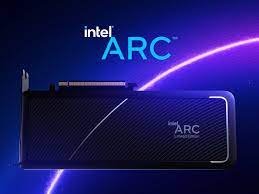Intel expanded its Arc graphics lineup on Tuesday by introducing a graphics card priced at $179, explicitly targeting budget-conscious gamers seeking quality performance at 1080p resolution.

This new addition, the Arc A580, falls between Intel’s entry-level A380 and mid-tier A700-series GPUs introduced last year. A quick look at the card’s specifications reveals that the A580 is essentially a streamlined version of the A750.
Both cards boast 8 GB of GDDR6 memory, offering a substantial 512 GB/s of memory bandwidth. However, the A580, the more affordable option, features a slightly reduced count of Xe graphics and ray-tracing units, dropping from 28 to 24.
Additionally, the A580 operates at a technically slower clock speed of 1.7 GHz, unlike the A750’s 2.05 GHz. Intel mentions that its launch partners, including Asrock, Sparkle, and Gunnir, have overclocked their A580 cards to 2 GHz.
These reductions in performance do have the benefit of a lower thermal design power (TDP) of 185 watts compared to the 225 watts required by the more potent A750 variants.
Regarding actual performance, Intel asserts that the A580 can handle high-quality 1080p gaming with frame rates exceeding 60 FPS in various titles. Intel even provided charts showcasing the A580 achieving 94 FPS in Shadow of the Tomb Raider with ray-traced shadows enabled, all without resorting to AI-upscaling techniques.
AI upscaling technology has recently gained popularity among GPU manufacturers to enhance frame rates on less powerful GPUs. Nvidia offers Deep Learning Super Sampling (DLSS), AMD has FidelityFX Super Resolution, and Intel has Xe Super Sampling (XeSS). These technologies employ various algorithms and machine learning to upscale lower-resolution frames to 1080p or higher, resulting in smoother gameplay.
It’s worth noting that game developers need to support these technologies to work effectively. Intel’s XeSS is supported in 64 titles, fewer than AMD’s FSR (139 titles) and Nvidia’s DLSS (300+ titles).
If a game does support XeSS, Intel claims that gamers can experience up to a 63 percent boost in frame rates when the feature is activated. When considering vendor-provided performance figures, it’s advisable to approach them skeptically.
Beyond gaming, Intel also highlights the A580’s dual AV1 media decoders and encoders. AV1 is a relatively new, royalty-free video codec known for its exceptional compression efficiency, surpassing existing codecs like H.265 by 20 to 40 percent.
However, the primary selling point of the Arc A580 is likely its competitive price point. Starting at $179, this card undercuts the market prices of its “closest competitors,” such as the Nvidia RTX 3050 and AMD RX 6600, by a margin of $25 to $50 based on current market conditions.








